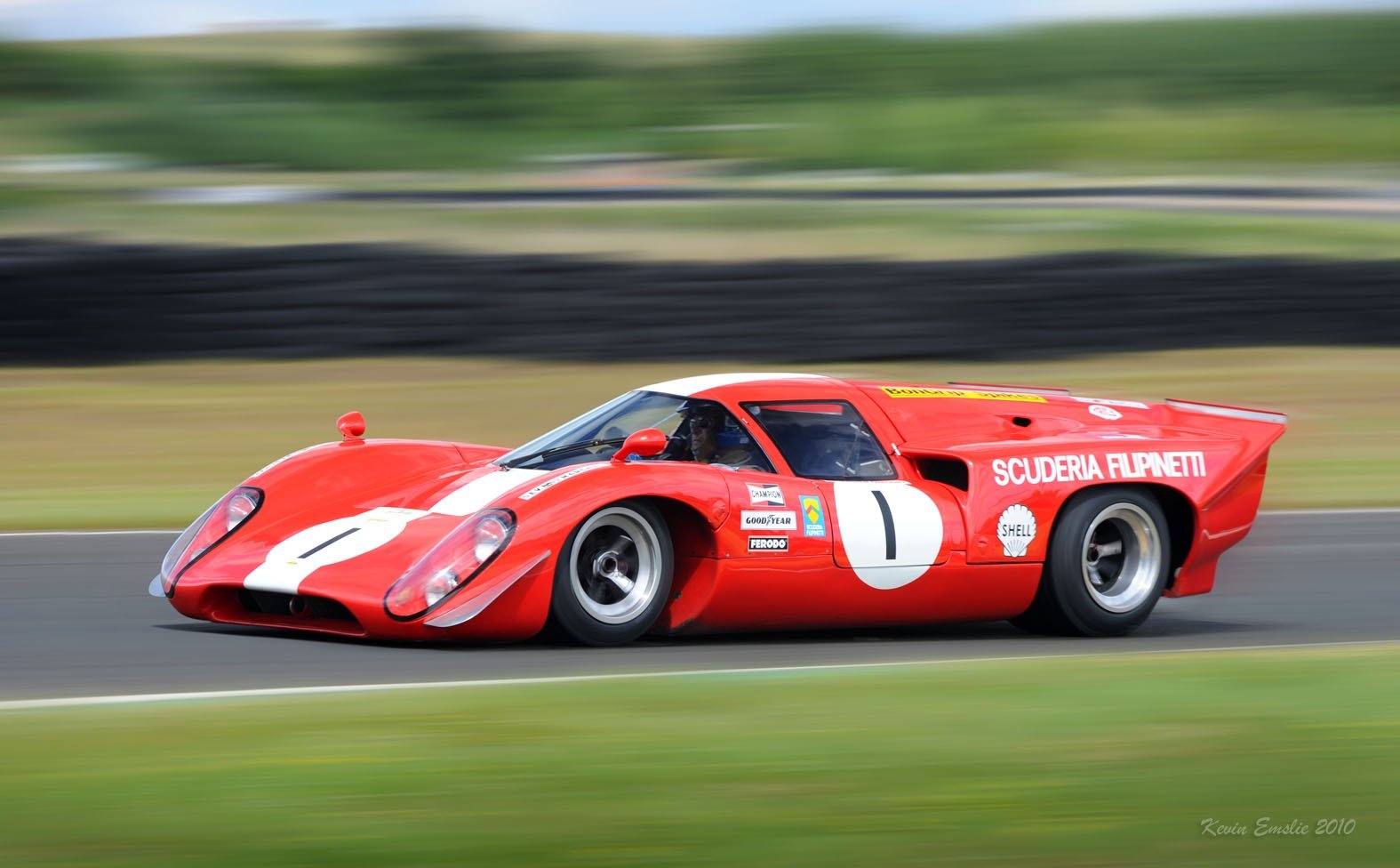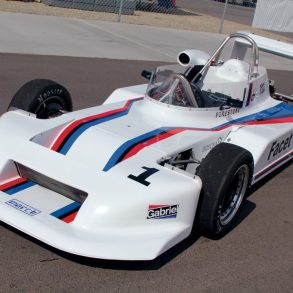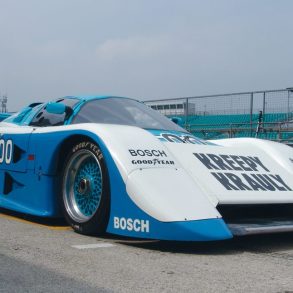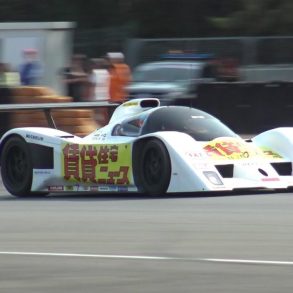Lola T70
Unlike Charles Cooper at Cooper Cars Lola’s Eric Broadley was quick to realize the sales potential for a car designed to accept a variety of production-based US engines. John Surtees and his early involvement with the Ford GT40 project, which had grown out of his Lola Mk6 GT may have had something to do with this. It was this experience that explains, at least in part, why Lola’s resulting T70 is remembered as one of the marque’s great cars, whereas the Lotus Types 30 and 40— designed for the same market — have gone down in history as failures.
It was John Surtees, whose Team Surtees joined forces with Lola Cars to form Lola Racing Ltd as a works development and racing arm who is rightly given much credit for the difference in results. Surtees honed the T70, and in his hands it quickly proved itself capable, with a Chevy V8 in the back, of circulating British circuits faster than contemporary F1 cars. “There are different criteria for a sportscar and an F1 car,” explains Surtees, outlining his philosophy for tuning the T70’s dynamics. “With a long-distance car you can’t have something that rides on a knife-edge like a top F1 car. When you’re testing and developing you’re trying to get consistency: you don’t want a volatile, unpredictable character. By the time the T70s got a bit of running into them they became very drivable, very predictable cars which you could drive up to the limit and perhaps a little bit over. This gave the driver confidence.”
“Eric created some very fine motor cars. The important thing about Lolas was that they were user-friendly, and I hope we contributed to making them so with the development work we did.” John Surtees – Motorsport Magazine
An unusual feature of the T70’s brakes was that the discs, front and rear, were mounted inboard of the uprights to liberate them from the wheel well. Surtees: “This wasn’t just for better cooling but to reduce the effect of temperature on tyre pressures. You don’t build a light car when you put a big lump like a Chevy in it, so there is a lot of heat generated. If you can keep it away from the tyres and wheels, all well and good.
The T70 has been described as a superb chassis lacking a competitive engine, but Surtees demurs:
“I’m not a great believer in using production-based engines in racing, but from the point of view of a series like Can-Am and letting it link in with the American public perception of racing, I actually think the Chevy engines were great.” Nonetheless, in an attempt to create an all-British package, Lola got into bed with Aston Martin in 1967. It was not a happy marriage. “The Aston V8 could have achieved so much but was a total disaster. We didn’t expect it to compete on out-and-out speed — we were hoping to a degree that weather would play a hand. If it rained a bit, as happened at the Nürburgring and the Le Mans practice, we were very competitive. Before Le Mans we did a long test at Goodwood, 10 or 12 hours, but in the race we lasted only a few laps because Aston Martin had changed the design of the head gaskets! As soon as we got the cars back from Le Mans, we took the Aston engines out and that was the end of that.” John Surtees – Motorsport Magazine
A second engine fiasco occurred when Surtees turned to Weslake to design and manufacture high-performance heads. “When the new aluminum-block Chevrolets became available they agreed to supply us with some, so we went to Weslake to build a batch of engines with special heads. In theory the engine should have been a winner: it was compact, had a nice layout with Lucas injection tucked away, and we took a bit of weight out of it. But the manufacturing let it down. We found we had one valve at one angle, another valve at a different angle. I had to ditch it.” A big accident during practice at Mosport brought Surtees’ 1965 season to a premature end, and very nearly accounted for JS himself. It was caused by poor stock control. “We’d been negotiating with Lola’s US distributor, John Mecom, who was looking to make a certain amount of the car in America. They had sent some parts over for inspection, some of which were suspension uprights. These had become mixed up and were fitted to the car without being checked. The core had moved when they’d been cast, leaving a very thin wall which had lasted previous races but shattered on that lap. I came past the pits and the right-front wheel came off. The car hit the guard rail, I came out and it dropped on me. Rather knocked me about — ruptured kidneys, a split pelvis, broken femur and a cracked lower spine.”
The T70’s competition career coincided with a period of dramatic advances in tyre design, which Surtees made certain to keep abreast of. “In my bike years I’d always been very involved with developing and testing tyres. On the car side I did some development with Dunlop, then I become associated with Firestone over the T70 programme. I did virtually all Firestone’s testing over here and they were very responsive to my input. The war between Goodyear and Firestone meant that there were continual advances that you had to keep pace with and take advantage of in the car’s development. There was a lot of work done on springs and dampers as a result—we worked very closely with Koni. That brought its problems, too, because as you improve tyres you put greater stress through everything, but the car retained its user-friendly character.” The Hewland LG500 was was designed to handle up to 550 bhp, and was the first Hewland box to employ an integral oil pump. The casing was finned magnesium alloy and the all-up weight was only 125lb. Fourteen different gear sets were provided, and it was possible to change all ratios in 30 minutes.
The Lola T70 was a welded and riveted sheet-metal monocoque, and Broadley was at last able to do what Roy Lunn had not allowed him to do on the GT40 – use alloy for parts of the tub. Front and rear sheet-steel box sections held the suspensions, a steel floor section extended to alloy pontoon fuel-tanks and light alloy transverse bulkheads. In the constant search for weight-saving, fuel bags were not used; instead, the tanks were epoxied on the inside seams. Even pipe brackets were eschewed, with polystyrene foam poured in which provided ample support for the pipework. Broadly designed the wheels at 15in, so that he could use very large Girling brake discs and large calipers. Still learning from the GT40, these discs were set into the airstream, and not shrouded by the wheels. Even the front disc calipers were set ahead of the disc into the airstream to aid cooling. This positioning of the discs also meant that should 14in or 13in wheels prove better in the future, they could be fitted without modification. Suspension was by conventional wishbones at the front, with inverted lower wishbones and single top links with twin radius-rods at the rear. The front anti-roll bar acted on the lower wishbones, with the rear anti-roll bar acting on the top links. Combined Armstrong coil-spring damper units were fitted all round. BMC stock rack-and-pinion steering was mounted high behind the front axle line. Fiberglass body panels were designed by Peter Jackson’s Specialized Moldings firm, as all other Lola bodies had been since the 1100.

Wheelbase of the Lola T70 was 7ft 11in, track front and rear 4ft 6in, overall length 13ft, width 5ft 8in, and height 31in. Developing such cars into winning racers was a major task. Bruce McLaren and Jim Hall did their own testing, and Lotus had Jim Clark to tame the awkward Lotus 20 and 40. For Lola, John Surtees, who had a long association with the firm in Formula One and Two cars, set up Team Surtees, effectively as a works team. The T70 was phenomenally fast in testing, and soon started shattering track, and even Formula One, records. For the inaugural Can-Am race a new Mk II was designed with a tub that was all alloy. The heavy spare wheel and radiators in the nose of the Mk I which had caused bad grounding under braking required stiffer springs to be fitted. A spare wheel was not going to be required under the 1966 regulations, and the redesign offered a lighter front end and sleeker nose, giving better airflow to the radiators. A second problem had been the epoxied fuel-tanks. The harder the cars raced, the more the chassis flexed, and eventually the tanks started leaking. Broadley reluctantly fitted bag tanks into the Mk II’s pontoons.
The sad note was John Surtees crashing the new Mk II in practice for the Pepsi 100 at the Canadian Grand Prix meeting at Mosport. Going through the right-handed turn one at high speed, the Lola’s front nearside hub-carrier broke and the suspension collapsed; the car went into a terrifying sequence of twisting vaults which took it over the guardrail and the earth bank beyond. Hurtling down the embankment, it came to rest near the tunnel under the track between turns one and two – upside down, with ignition on, fuel-tanks ruptured and Surtees pinned underneath, unconscious. Two brave marshals saved his life. Ted Milton scraped the dirt and sand from his face so he could breathe, whilst Jim Swan crawled under the car and turned off the ignition. John was rushed to hospital, but by the middle of 1966 was back to winning races. The wrecked Lola was buried at Mosport, and now rests under the tarmac of the parking lots of a Bowmanville shopping precinct.
Miraculously Surtees was back in time for the first race of the 1966 season. During that first season of Can-Am the Lola T70 Mk II won 5 out of 6 races and Surtees was crowned Can-Am Champion.
Penske would also be running a Lola, but with a big-block Chevy 427 engine. When they entered a couple of shake down race in Canada ,Donohue found that the big Chevy wouldn’t maintain any oil pressure in the corners, which was later found to be a problem with the engine. After a disastrous beginning to the season the engine was sent back to Detroit for more work on the oil-system. Eventually they gave up on the big-block and reverted to a small-block for the Can-Am series.
















